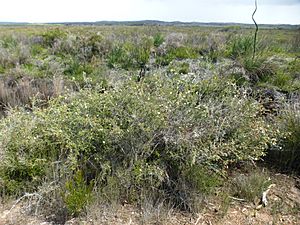Grey honey-myrtle facts for kids
Quick facts for kids Grey honey-myrtle |
|
|---|---|
 |
|
| M. incana growing near Point d'Entrecasteaux. | |
| Scientific classification | |
| Genus: |
Melaleuca
|
| Species: |
incana
|
| Subspecies | |
The Grey honey-myrtle (scientific name: Melaleuca incana) is a special plant. It belongs to the myrtle family, called Myrtaceae. This plant is native to the south-west part of Western Australia. It also grows naturally in southern Victoria.
People often grow the Grey honey-myrtle in their gardens. It produces many white or creamy yellow flowers. These flowers bloom in spring and sometimes have a lovely scent.
Contents
What the Grey Honey-Myrtle Looks Like
The Grey honey-myrtle can be a bush or a small tree. It usually grows up to about 5 meters (16 feet) tall. Its bark is either stringy or peels off in layers.
Leaves and Branches
The leaves grow in groups of three, or sometimes four, around the branches. They are quite small, about 3.5 to 17 millimeters (0.1 to 0.7 inches) long. They are also very narrow, only about 0.5 to 3.5 millimeters (0.02 to 0.14 inches) wide.
The leaves and young branches are covered with soft, fine hairs. This gives the plant's leaves a greyish look.
Flowers and Fruit
The flowers grow in spikes, usually at the ends of the branches. The branches keep growing even after the flowers appear. Each spike can have between 6 and 55 individual flowers.
These spikes are up to 30 millimeters (1.2 inches) long and 15 millimeters (0.6 inches) wide. The flowers can be white, creamy white, or yellow. The small petals, about 0.7 to 2.0 millimeters (0.03 to 0.08 inches) long, fall off as the flower gets older.
The flowers have five groups of stamens, which are the parts that make pollen. Each group has between 3 and 11 stamens. The Grey honey-myrtle flowers in spring. After flowering, it produces woody fruits called capsules. These capsules are 1.5 to 4 millimeters (0.06 to 0.16 inches) long. They grow in cylinder-shaped clusters up to 30 millimeters (1.2 inches) long.
How It Got Its Name
The Grey honey-myrtle was first officially described in 1819. A botanist named Robert Brown gave it its scientific name. He wrote about it in a book called Edward's Botanical Register.
The name incana comes from a Latin word. Incanus means "quite grey." This name was chosen because of the grey color of the plant's leaves.
Different Types of Grey Honey-Myrtle
There are two main types, or subspecies, of the Grey honey-myrtle. They are a bit different in how they grow, the shape and size of their leaves, when they flower, and where they are found.
- M. incana subsp. incana grows along the south-west coast of Western Australia. You can find it between Albany and Jurien Bay. It also grows further inland and naturally in parts of Victoria.
- M. incana subsp. tenella grows along the south coast of Western Australia. It is found between Albany and Esperance.
Where It Grows
This melaleuca plant grows in the south-west of Western Australia. It can be found as far east as Esperance. It likes to grow near swamps, in low woodlands, and in heathlands. It prefers peaty soil and sand.
Is It Endangered?
The Grey honey-myrtle is currently not considered an endangered plant. The Government of Western Australia Department of Parks and Wildlife lists it as "not threatened." This means there are plenty of these plants in the wild.
Growing It in Gardens
The Grey honey-myrtle is a popular plant for gardens, especially the incana subspecies. It is a strong plant that grows quickly. It can handle many different types of soil and conditions once it has settled in. It can also survive frost.
You can often buy this plant at garden stores. It can be trimmed to form a hedge. Sometimes, tiny insects called scale insects might try to live on it.
Related Pages
- Melaleuca incana subsp. incana, commonly known as grey honey-myrtle.
Images for kids
-
Habit near Point d'Entrecasteaux




